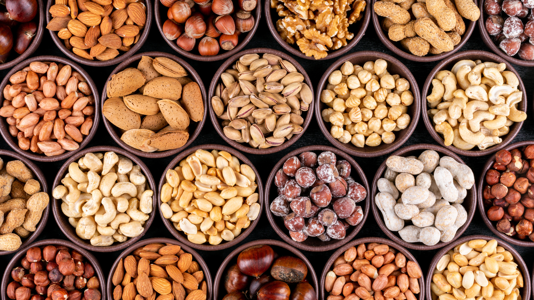When to Eat Dry Fruits as Per Ayurveda

In a world with a fast-paced lifestyle and ever-changing food trends, it’s easy to ignore Ayurveda’s ageless wisdom. This ancient school of medicine, which originated in India over 5,000 years ago, focuses not only on healing but also on sickness prevention through a holistic approach to health and nutrition. The eating of dry fruits, which are nutrient-rich powerhouses, is an important element of Ayurveda. In this post, we will look at the Ayurvedic perspective on dry fruits, the methods for their intake, and principles for achieving optimal health and well-being.
Selecting Dry Fruits According to Your Dosha
Since Ayurveda categorizes individuals into three bodily types: vata, pitta, and kapha, it recommends dry fruits based on their predominant dosha for balance and well-being. Let’s explore each dosha and the corresponding dry fruit choices:
Vata Dosha
Vata, linked to ether and air, is associated with imaginative, exuberant, mood-swinging individuals, anxiety, irritable bowel syndrome, and dry skin.
Vata people should opt for dry fruits like walnuts and almonds for their warmth and anchoring properties, which balance their preference for coolness and lightness.
Pitta Dosha
Pitta's personality, characterized by fire and water elements, is enthusiastic, motivated, goal-oriented, and fast-metabolizing, but may also experience inflammatory, acidic, and irritable conditions.
Pitta-type individuals benefit from selecting cooling dry fruits like dates and raisins, as they naturally balance their fiery temperament and cool down overheated systems.
Kapha Dosha
Kapha, linked to soil and water characteristics, influences stability, compassion, and physical strength. However, it can also cause constipation, weight gain, and poor digestion.
For those with a Kapha constitution, incorporating dried figs and apricots into your diet can promote balance and vitality by counteracting Kapha’s heaviness and coldness.
The Importance of Soaking for Digestion
In Ayurveda, proper digestion is paramount. While dry fruits are nutrient-rich, they can sometimes be hard to digest and may aggravate certain doshas, particularly Pitta. The Ayurvedic practice of soaking these fruits enhances their digestibility, making them suitable for all doshas. Once soaked, dry fruits not only become easier to chew and digest but also release their nutrients more effectively. This process further renders them more hydrating and nourishing for the body.
Balancing Dry Fruits with Other Foods
Ayurveda places a strong emphasis on the need to mix foods to make meals that are well-balanced and simple to digest. Ayurveda advises matching dry fruits with complementing foods to maximize their health benefits.
Combining with Dairy
In Ayurveda, soaked and peeled almonds often pair with dairy products like milk or ghee to create a nutritious and easily digestible meal.
Combining with Spices
Spices like cardamom, cinnamon, and nutmeg enhance the taste and digestion of dry fruits, providing therapeutic benefits.
Moderation is Key
The key to optimal health is moderation. Enjoy a modest handful of soaked and peeled dry fruits a few times per week for maximum well-being to avoid imbalances and overheating.
Timing Matters
The timing of meal consumption is important to digestion and general health, according to Ayurveda. No exception is made for dry fruits, and Ayurveda provides guidance on when to eat them.
Morning
Eating dry fruits first thing in the morning gives your day a strong start. A little dose of raisins, walnuts or almonds that have been soaked overnight will give you a healthy morning boost.
During Meals
Dry fruits are a great option for a balanced snack in between meals. Their high nutrient content can help keep blood sugar levels steady and curb cravings.



